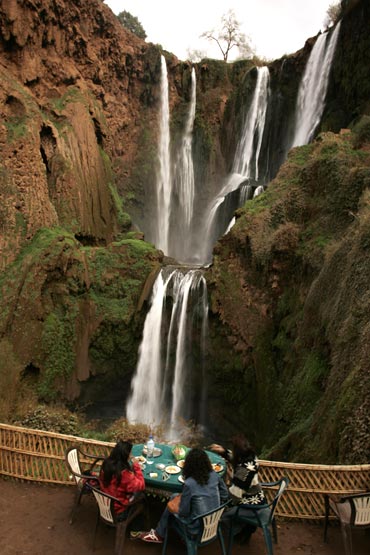 | « Back to article | Print this article |
Sex and the City: The Morocco connection
Romantic landscapes. Enchanting souks. Affable people. Bollywood. In a special series, Arthur J Pais takes a magical, mystery tour of Morocco.
Earlier in the series:
Desi in magical Morocco
The Casablanca massage
'Every Moroccan will know at least 100 words in Hindi'
Look, it's Tibet over there, says a studio hand, pointing beyond the high Atlas mountains in southern Morocco.
He has a broad smile on his face as he starts talking about how Martin Scorsese, unable to shoot the Dalai Lama biopic in Tibet, shot much of his 1997 film Kundun in Morocco. He had earlier also shot many scenes from The Last Temptation of Christ (1988) in Morocco too.
Studio heads in Ouarzazate, south central Morocco, boast about the country being one of the major locale providers for Hollywood and European films. It has also doubled as a British Raj backdrop for The Man Who Would Be King, the 1975 film, adapted by John Huston from the Rudyard Kipling story of the same name. A story of ambition, greed and corruption, the film featured Sean Connery, Michael Caine, Saeed Jaffrey and Christopher Plummer.
Huston wanted to shoot the film in India, but Indira Gandhi's government was not keen, given Kipling's then recent reputation as a defender of British rule in India.
A visit to Morocco is not really complete without visiting the desert region, the oases, the immense gorges and a handful of movie studios in Ouarzazate, a city nicknamed the door of the desert. Orson Welles shot a substantial part of his Othello here in 1952. Alfred Hitchcock incorporated quite a few scenes from his Moroccan shoot in The Man Who Knew Too Much (1956) and David Lean used the Moroccan desert for much of his Lawrence of Arabia (1962).
The number of recent Hollywood films shot here, including Prince of Persia: The Sands of Time, is quite impressive. Morocco has been rather slow in drawing in Bollywood but with Saif Ali Khan choosing to shoot part of Agent Vinod here with Kareena Kapoor, more Bollywood producers may consider Morocco as a venue for their productions.
At least a dozen films are shot in Morocco each year by Hollywood and European producers. Some stories have an Arab background, but many use the tremendous variety of Moroccan natural backdrops, ranging from the desert to its mountains to the awesome beaches. Shooting a film in Morocco, instead of Arizona or New Mexico, can shave off some 30 percent of the budget.
From Oliver Stone, who made Alexander (2004) in Morocco, to Ridley Scott who shot part of his films: Gladiator (2000), Black Hawk Down (2001), Kingdom of Heaven (2004) and Body of Lies (2008) in Morocco, Hollywood producers have praised the professional help they receive to make their films in this north African country.
"Morocco is just about four hours from London, but we offer a very different universe to film producers," says Abdel Hasan, a studio publicist. "Whether your film is set in a period 2,000 years old or is telling a recent story, we can provide the locations. And they are all just about 200 miles from Casablanca [the biggest city in the country]."
Among the most popular destinations in Morocco for Hollywood and European filmmakers are Marrakesh, Erfoud (eastern Morocco that affords beautiful views of the Sahara desert) and Agadir (an ocean front Berber city in southwest Morocco).
But never make the mistake of trying to identify Moroccan locations in the 1942 tearjerker classic Casablanca. The movie, which turns up on television every sixth month or so, was shot entirely on a Warner Brothers studio lot in Hollywood.
You will surely have fun trying to locate scenes in Sex and the City as well as Inception, both of which were shot in Morocco.Earlier in the series:
Desi in magical Morocco
The Casablanca massage
'Every Moroccan will know at least 100 words in Hindi'
